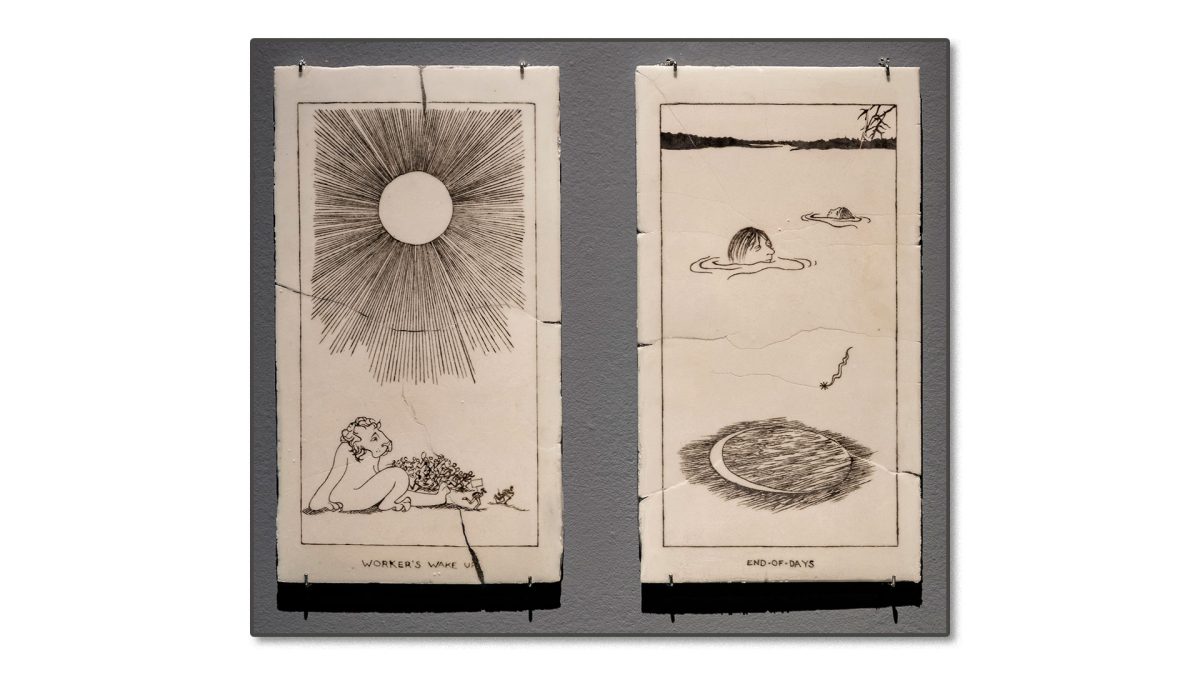A new exhibit comes to Bucks Newtown Campus, creatively displaying responses to social, cultural, architectural, ecological and environmental sustainability throughout urban and rural environments.
From Jan. 19 until March 9, 2024, “Construction Time Again” will be on view at the Hicks Art Center Gallery on the Newtown Buck’s Campus. The initial idea came from a student film about litter to show environmental decline and gentrification.
The title “Construction Time Again” was coined by all participating artists and architects. The exhibit is named after the title of the 1983 studio album by Depeche Mode. Clifford Eberly, an exhibit associate at Bucks highlighted these Depeche Mode lyrics that are important to the meaning of the exhibit, “The landscape is changing … Now we’re re-arranging, there’s no use denying, Mountains and valleys, can’t you hear them sighing.”
The artists use a diverse range of materials, subjects and media to address the impacts of construction and demolition using a variety of materials such as glass, sand, seaweed, photography and even borrowed objects from the local Mercer Museum in Doylestown, Pennsylvania. The idea was to use objects to reduce, reuse, and recycle.
The “Construction Time Again” exhibit is made up of various art, media styles and genres. Many of the artists are local, including students’ and past professors’ works.
Eberly said, “The objects and works in the exhibition challenge us to evaluate our collective responses and responsibilities to outcomes of our presence on Earth and seek new ways of sustainable resourcefulness.”
This exhibit challenges the audience, “to fully understand and interpret what is going on around you through senses, observation, and perspective” said Eberly, who added seeing the exhibition through air, water and traceries of building sites helps viewers to interpret the constantly changing environments.
One of the artists, Gwendolyn Kerber, an American painter based in Berline and Newtown, PA, created a piece for the exhibit called, “Wading; Field of Vision Looking Down at a 45-Degree Angle from About Two Feet Away.” This piece uses grids, color and vantage points, while also using different materials like wood and wire to create structure.
She wanted to help the audience visualize how we see the natural world along with man-made environments like buildings. Taking a step back by two feet while looking at her piece, the viewer could look into her structure as if it were water.
Another artist collaborator Arden Bendler Browning, a Philadelphia-based artist, created an augmented reality video/painting that collides with gestural, abstract paintings of buildings and landscapes. Using sight and observation the exhibit allows the audience to understand movements in our surroundings that can be life threatening or affirming according to Eberly.
Daine Burko’s paintings, “Deforestation 1” and “Deforestation 2” display the rapid loss of the Amazon rainforest. Burko wanted to represent the current Brazilian government’s lack of responsibility for our environment. The paintings showcase corporate greed and the proliferation of fossil fuels. The viewer is given the perspective of having no escape from these tragedies as the government controls our surroundings.
Eberly said, “We’ve seen and smelled these effects of Wildfires on accident and by governments. It shows we can not control what happens around us even if it affects us.”
Jean-François Delorme, who worked as a wood tuner with a focus on production and exhibited individual items in ceramics and glass, created, “Broken.” This sculpture consists of crutches holding up a half-wooden sphere breaking apart. This exhibit is meant to represent Earth’s environmental suffering and breakdown while barely being held up.
Bucks Part-Time Fine Arts Professor Deborah Riccardi’s family faced devastation after an accidental fire in an auto body shop her father owned which destroyed his property. They had to fight with the local government in Ambler Pennsylvania to get eminent domain. Riccardi and her sister took photos of her father on the property and displayed the photos in “Construction Time Again.” The family was able to properly recycle the remains.
Santa Monica City Hall and Guyot Hall at Princeton University were redesigned by Frederick Fisher and Partners. The videos and plans for these projects are on display in the exhibit. The Architects are able to create renovated buildings in sustainable ways.
Korean-American Artist and Photographer Soo Kim’s, “Study, City Beautiful #1” and stacked sliced and cut images to create rural and urban landscapes. She “calls attention to the Western Influence of the master-planned city,” said Eberly.
Nicolo Gentile, a Philadelphia-based artist, created sculptures using melted-down metals from the now-demolished “12th Street Gym” in Philadelphia. This gym was a vital part of the gay community and had over 4,000 members at one point according to Eberly. His sculptures show a sustainable use of resources and a historical lens in the 12th Street Gym community.
Kristen Neville Taylor, a Philadelphia-based artist, “End of Days” explores, “the myths and lore around the evolution of the sand mines in New Jersey Pine Barrens that have mostly vanished” according to Eberly. Her videos and sculptures represent the depletion of natural resources.
For more information about “Construction Time Again” visit https://www.bucks.edu/culture/hicks/


